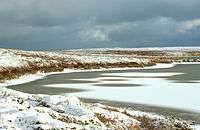Izembek National Wildlife Refuge
| Izembek National Wildlife Refuge | |
|---|---|
|
IUCN category IV (habitat/species management area) | |
 Map of the United States | |
| Location | Aleutians East Borough, Alaska, United States |
| Nearest city | Cold Bay, Alaska |
| Coordinates | 55°15′N 162°45′W / 55.250°N 162.750°WCoordinates: 55°15′N 162°45′W / 55.250°N 162.750°W |
| Area | 315,000 acres (1,270 km2)[1][2] |
| Established | 1980 |
| Governing body | U.S. Fish and Wildlife Service |
| Website | Izembek NWR |
| Designated | December 18, 1986 |

The Izembek National Wildlife Refuge is the smallest of the National Wildlife Refuges located in the U.S. state of Alaska. It lies on the northwest (Bering Sea) coastal side of central Aleutians East Borough. Most of the refuge (300,000 acres) was designated as Wilderness in 1980 under the Alaska National Interest Lands Conservation Act.[1] The refuge is administered from offices in Cold Bay.
Izembek National Wildlife Refuge lies between the highly productive waters of the Bering Sea and the Gulf of Alaska. Within the heart of the refuge is Izembek Lagoon, a 30-mile (48 km) long and 5-mile (8.0 km) wide coastal ecosystem that contains one of the world's largest eelgrass (Zostera marina) beds. More than 200 species of wildlife and nine species of fish can be found on the refuge. Millions of migratory waterfowl and shorebirds find food and shelter in the coastal lagoons and freshwater wetlands on their way to and from their subarctic and arctic breeding grounds. This extraordinary abundance and diversity of waterfowl has attracted international attention. In 1986, Izembek National Wildlife Refuge and Izembek State Game Refuge, which encompasses the submerged land of Izembek Lagoon, was the first wetland area in the United States to be recognized as a Wetland of International Importance by the Ramsar Convention. In 2001, Izembek Refuge was also designated as a Globally Important Bird Area by the National Audubon Society.[1][3]
A contentious bill before Congress proposes a land-swap of 43,000 acres (170 km2) of state land for a single-lane 17-mile (27 km) road connecting King Cove to Cold Bay, passing through Izembek NWR. The bill is supported by the Republicans as well as the local residents and mayor of the Aleutians East Borough, part of Izembek. However, environmentalists contend the road undermines the pristine wildlife and threatens the population of the migratory black brant.[2]
Fauna
Mammals that roam this refuge are brown bears and caribou. Raptors which prey on the many species of snakes, rodents, and fish in this area including bald and golden eagles, rough-legged hawks, gyrfalcons, and Peale's peregrine falcons. Marine mammals are common in the productive waters surrounding this refuge. Harbor seals, Steller's sea lions, and sea otters inhabit nearby coastal waters and lagoons. Harbor seals frequently haul out on sandbars in the lagoons and along the coast. killer, gray, and minke whales can be seen as they migrate along the shoreline and occasionally inside of Izembek Lagoon.

 Lefthand Valley Wilderness Area
Lefthand Valley Wilderness Area Aghileen Pinnacles
Aghileen Pinnacles
| Wikimedia Commons has media related to Izembek National Wildlife Refuge. |
References
- 1 2 3 Izembek National Wildlife Refuge
- 1 2 New York Times article on Land Swap
- ↑ "Izembek-Moffet-Kinzarof Lagoons". http://www.audubon.org/important-bird-areas/izembek-moffet-kinzarof-lagoons. Retrieved May 17, 2017. External link in
|website=(help)
External links
- Official site
- New York Times article on Land Swap
- Important Bird Areas-National Audubon Society